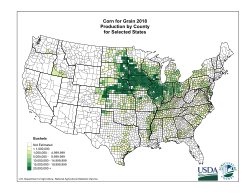Corn Belt
The Corn Belt is a region of the Midwestern United States that, since the 1850s, has dominated corn production in the United States. In the United States, "corn" is the common word for "maize". More generally, the concept of the "Corn Belt" connotes the area of the Midwest dominated by farming and agriculture.[1][2]
Corn Belt | |
|---|---|
Agricultural or cultural region of the United States | |
 2018 production of corn in the United States | |
| Country | |
| States | |

Geography
There is lack of consensus regarding the constituents of the Corn Belt, although it often includes: Iowa, Illinois, Indiana, southern Michigan, western Ohio, eastern Nebraska, eastern Kansas, southern Minnesota, and parts of Missouri.[3] It also sometimes includes: South Dakota, North Dakota, all of Ohio, Wisconsin, all of Michigan, and Kentucky.[4]
The region is characterized by level land, deep fertile soils, and a high organic soil concentration.[5]
As of 2008, the top four corn-producing states were Iowa, Illinois, Nebraska, and Minnesota, accounting for more than half of the corn growth in the United States.[6]
More recently, the USA corn belt was mapped at the county level using the Landuse and Agricultural Management Practices web-Service (LAMPS)[7], along with animated maps of changes in time (2010-2016).[8]
History
On account of new agricultural technology developments between 1860 and 1970, the Corn Belt went from producing mixed crops and livestock into becoming an area focused strictly on wheat-cash planting. After 1970, increased crop and meat production required an export outlet, but global recession and a strong dollar reduced exports and created serious problems even for the best farm managers.[3]
In 1956, former Vice President Henry A. Wallace, a pioneer of hybrid seed, declared that the Corn Belt has developed the "most productive agricultural civilization the world has ever seen".[9]
Most corn grown today is fed to livestock, especially hogs and poultry. In recent decades soybeans have grown in importance. The U.S. produces 40% of the world crop.[10]
By 1950, 99% of corn has been grown from hybrids.
EPA Ecoregion
In 1997, the USEPA published its report on United States' ecoregions, in part based on "land use". Its "Level III" region classification contains three contiguous "Corn Belt" regions, Western (47), Central (54), and Eastern (55), stretching from Indiana to eastern Nebraska.[11][12]
Panoramic view
See also
- Banana Belt
- Breadbasket
- Canadian Prairies, Canada's 'Breadbasket'
- Central Black Earth Region, segment of the Eurasian chernozem belt that lies within Central Russia
- Palliser's Triangle, Canada's semi-arid grain production region
- Peak wheat
References
- John Mark Hansen, Gaining access: Congress and the farm lobby, 1919-1981 (1991) p. 138
- Thomas F. McIlwraith and Edward K. Muller, North America: the historical geography of a changing continent (2001) p, 186
- Hart (1986)
- U.S. Department of Agriculture
- Corn Belt, Encyclopædia Britannica Online
- USDA State Fact sheets
- , Kipka et al. 2016, Development of the Land-use and Agricultural Management Practice web-Service (LAMPS) for generating crop rotations in space and time, Soil & Tillage Research, Vol 155, p, 233-249.
- , Green et al. 2018, Where is the USA Corn Belt, and how is it changing? Sci. Total Environment, Vol. 618, p. 1613-1618.
- Edward L. Schapsmeier and Frederick H. Schapsmeier, Prophet in Politics: Henry A. Wallace and the War Years, 1940-1965 (1970) p, 234
- Smith, C. Wayne., Javier Betrán, and E. C. A. Runge. Corn: Origin, History, Technology, and Production. Hoboken, NJ: John Wiley, 2004. page 4. Print
- "Ecological Regions of North America: Toward a Common Perspective" (PDF). Commission for Environmental Cooperation. 1997. Retrieved 2018-02-26.
- "Ecoregion Maps and GIS Resources". United States Environmental Protection Agency. Retrieved 2008-04-10.
Further reading
- Anderson, J. L. Industrializing the Corn Belt: Agriculture, Technology, and Environment, 1945-1972 (2009) 238 pp. ISBN 978-0-87580-392-0
- Bogue, Allan. From Prairie to Corn Belt: Farming on the Illinois and Iowa Prairies in the Nineteenth Century (1963) excerpt and text search
- Cayton, Andrew, et al. eds. The American Midwest: An Interpretive Encyclopedia (2006) excerpt and text search
- Hart, John Fraser. "Change in the Corn Belt", Geographical Review, Jan 1986, Vol. 76#1 pp. 51–72
- Hudson, John C. Making the Corn Belt: A Geographical History of Middle-Western Agriculture (1994)
- Power, Richard Lyle. Planting Corn Belt Culture: The Impress of the Upland Southerner and Yankee in the old Northwest (1953)
- Snapp, Roscoe R. Beef Cattle Their Feeding and Management in the Corn Belt States (1950)
- Smith, C. Wayne, et al. Corn: Origin, History, Technology, and Production (2004) online edition
- Wallace, Henry Agard. Henry A. Wallace's Irrigation Frontier: On the Trail of the Corn Belt Farmer 1909 15 articles written by Wallace in 1909; 1991 edition edited by Richard Lowitt, and Judith Fabry
| Wikimedia Commons has media related to Maize. |
